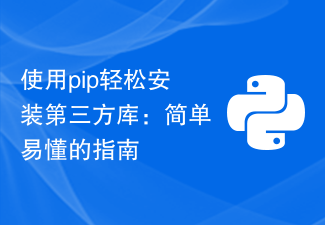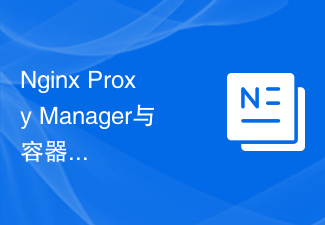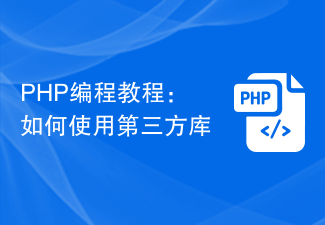 Backend Development
Backend Development Python Tutorial
Python Tutorial A practical guide to install third-party libraries through pip to improve development efficiency
A practical guide to install third-party libraries through pip to improve development efficiency
Practical Guide: Using pip to install third-party libraries to improve development efficiency
Introduction:
In the software development process, we often use various third-party library. These libraries provide rich functionality and tools that can help us develop and deploy applications more efficiently. Python's package management tool pip is a powerful tool that can help us easily install and manage third-party libraries. This article will introduce how to use pip to install third-party libraries and give some specific code examples.
1. Installation of pip
If you are using Python version 3.4 or higher, then pip is already installed. If you are using an old version of Python, you can go to pip's official website (https://pip.pypa.io/en/stable/installing/) to download the corresponding version of the installation package and install it manually. After the installation is complete, you can enter the "pip" command in the command line window to verify whether the installation was successful.
2. Use pip to install third-party libraries
The use of pip is very simple. You only need to enter "pip install package name" in the command line, and pip will automatically install it from the Python Package Index (PyPI for short). Download and install the specified package. The following are some commonly used pip command examples:
-
Install a specified version of the package:
pip install package name==version numberFor example: pip install django= =2.2.6
This command will download and install the Django version 2.2.6 package from PyPI.
-
Update the installed package:
pip install --upgrade package nameFor example: pip install --upgrade django
This command Will check the version of the currently installed Django package and download and install the latest version of the Django package from PyPI.
-
Install the specified package and its dependent packages:
pip install -r requirements.txtYou can install all third-party libraries and their versions that need to be installed Save the number in a file called requirements.txt, and then use this command to install all packages and dependencies at once.
3. Specific examples of using pip to improve development efficiency
The following gives several third-party libraries commonly used in actual development and explains how to use pip to install them.
- Django: A high-level Python web framework for developing web applications.
Installation command: pip install django - NumPy: A powerful library for scientific computing.
Installation command: pip install numpy - Requests: A library for sending HTTP requests, very suitable for web development.
Installation command: pip install requests - Pandas: a library for data analysis and data processing.
Installation command: pip install pandas - Matplotlib: A library for drawing charts and visualizing data.
Installation command: pip install matplotlib
4. Summary
pip is a very powerful and convenient tool that can help us easily install and manage third-party libraries. This article explains how to install pip and provides specific examples of how to use pip to install third-party libraries. In daily development, rational use of pip to install third-party libraries suitable for project needs can greatly improve development efficiency and reduce development time. I hope this article will be helpful to everyone and contribute to your development journey.
The above is the detailed content of A practical guide to install third-party libraries through pip to improve development efficiency. For more information, please follow other related articles on the PHP Chinese website!
 如何在Go中使用第三方库?May 11, 2023 pm 03:30 PM
如何在Go中使用第三方库?May 11, 2023 pm 03:30 PM在Go语言中,使用第三方库是非常方便的。许多优秀的第三方库和框架可以帮助我们快速地开发应用程序,同时也减少了我们自己编写代码的工作量。但是如何正确地使用第三方库,确保其稳定性和可靠性,是我们必须了解的一个问题。本文将从以下几个方面介绍如何使用第三方库,并结合具体例子进行讲解。一、第三方库的获取Go语言中获取第三方库有以下两种方式:1.使用goget命令首先
 Go 语言中的第三方库怎样安装和使用?Jun 10, 2023 am 08:15 AM
Go 语言中的第三方库怎样安装和使用?Jun 10, 2023 am 08:15 AMGo语言中的第三方库怎样安装和使用?Go语言已经成为了现代编程语言中最受欢迎的之一,因为它具有很多非常有用的特性和好处。它是一门非常容易上手的语言,可以用来编写各种各样的程序。与许多其他编程语言类似,Go也有大量的第三方库,它们可以帮助你更高效地编写代码,并且提供了非常多的功能和模块化的组件化结构。本文将介绍如何使用Go的第三方库。查找和选择第三方
 使用pip轻松安装第三方库:简单易懂的指南Jan 27, 2024 am 09:07 AM
使用pip轻松安装第三方库:简单易懂的指南Jan 27, 2024 am 09:07 AM简单易懂的教程:如何使用pip安装第三方库,需要具体代码示例引言:在Python开发中,我们经常需要使用第三方库来实现各种功能。而pip是Python的包管理工具,它可以帮助我们快速、方便地安装和管理第三方库。本文将向大家介绍如何使用pip安装第三方库,并给出具体的代码示例。步骤一:检查Python和pip的安装情况在开始之前,我们需要先检查一下Python
 Nginx Proxy Manager与容器编排工具的集成:提升开发效率Sep 27, 2023 am 08:24 AM
Nginx Proxy Manager与容器编排工具的集成:提升开发效率Sep 27, 2023 am 08:24 AMNginxProxyManager与容器编排工具的集成:提升开发效率引言:在现代软件开发领域,容器化技术已经成为主流趋势。容器化技术使得软件的部署与管理变得更加简单和高效,但同时也带来了一些新的挑战,例如容器的网络通信和负载均衡等问题。为了解决这些问题,NginxProxyManager成为了一个很好的选择。本文将介绍NginxProxyMana
 pip怎么安装第三方库Dec 12, 2023 pm 05:31 PM
pip怎么安装第三方库Dec 12, 2023 pm 05:31 PM安装步骤:1、打开命令行界面,输入“pip install library_name”命令来安装指定的库,其中library_name是要安装的库的名称;2、若想安装特定版本的库,可以使用==符号指定版本号。例如:pip install requests==2.25.1;3、若想升级已安装的库到最新版本,可以使用--upgrade选项。
 解决Vue报错:无法正确引入第三方库,如何解决?Aug 18, 2023 am 10:37 AM
解决Vue报错:无法正确引入第三方库,如何解决?Aug 18, 2023 am 10:37 AM解决Vue报错:无法正确引入第三方库,如何解决?引入第三方库是在Vue开发中常见的需求,它可以帮助我们处理一些特定的业务逻辑或提供一些功能的支持。然而,在引入第三方库的过程中,我们可能会遇到一些报错,这给我们的开发带来了一些困扰。本文将介绍一些常见的问题和解决方案,以帮助读者更好地处理这些报错。问题1:找不到第三方库当我们尝试使用import语句引入第三方库
 PHP编程教程:如何使用第三方库Aug 26, 2023 pm 07:54 PM
PHP编程教程:如何使用第三方库Aug 26, 2023 pm 07:54 PMPHP编程教程:如何使用第三方库引言:在PHP程序开发中,有时需使用第三方库来提供额外的功能和工具。这些库可以大大减少代码量,提高开发效率。本教程将介绍如何使用第三方库,并提供代码示例。了解第三方库的种类第三方库是由其他开发者编写和维护的代码集合。常见的第三方库包括数据库操作库、图像处理库、表单验证库等。这些库可通过Composer(PHP的包管理工具
 如何使用第三方库和扩展提升 PHP 函数的性能?Apr 25, 2024 pm 10:12 PM
如何使用第三方库和扩展提升 PHP 函数的性能?Apr 25, 2024 pm 10:12 PM优化PHP函数性能最有效的方法是使用第三方库和扩展。第三方库如predis(用于Redis)和guzzlehttp(用于HTTP)可以提高性能和吞吐量。扩展库如igbinary(用于数据序列化)和phpredis(用于Redis)可以提供原生接口和更快的速度。例如,使用Redis缓存和Memcached可以显着加速PHP应用程序,从而增强性能和用户体验。


Hot AI Tools

Undresser.AI Undress
AI-powered app for creating realistic nude photos

AI Clothes Remover
Online AI tool for removing clothes from photos.

Undress AI Tool
Undress images for free

Clothoff.io
AI clothes remover

AI Hentai Generator
Generate AI Hentai for free.

Hot Article

Hot Tools

EditPlus Chinese cracked version
Small size, syntax highlighting, does not support code prompt function

VSCode Windows 64-bit Download
A free and powerful IDE editor launched by Microsoft

Dreamweaver Mac version
Visual web development tools

MinGW - Minimalist GNU for Windows
This project is in the process of being migrated to osdn.net/projects/mingw, you can continue to follow us there. MinGW: A native Windows port of the GNU Compiler Collection (GCC), freely distributable import libraries and header files for building native Windows applications; includes extensions to the MSVC runtime to support C99 functionality. All MinGW software can run on 64-bit Windows platforms.

PhpStorm Mac version
The latest (2018.2.1) professional PHP integrated development tool




